University Economics Assignment: Problems and Solutions
VerifiedAdded on 2023/01/20
|11
|1889
|47
Homework Assignment
AI Summary
This document provides a comprehensive set of solutions to an economics assignment. The assignment covers key microeconomic concepts, including the economic problem, the three fundamental economic questions, positive and normative economics, and the impact of various factors on the production possibility curve. It also delves into demand and supply analysis, exploring price elasticity, factors affecting demand, and the relationship between price and total revenue. Furthermore, the assignment addresses externalities, illustrating the impact of loud music and vaccinations. Finally, it examines cost analysis, covering total product, fixed and variable costs, marginal cost, and the law of diminishing marginal returns. The solutions are supported by relevant economic theories and include calculations where necessary. The assignment concludes with a reference list of academic resources.
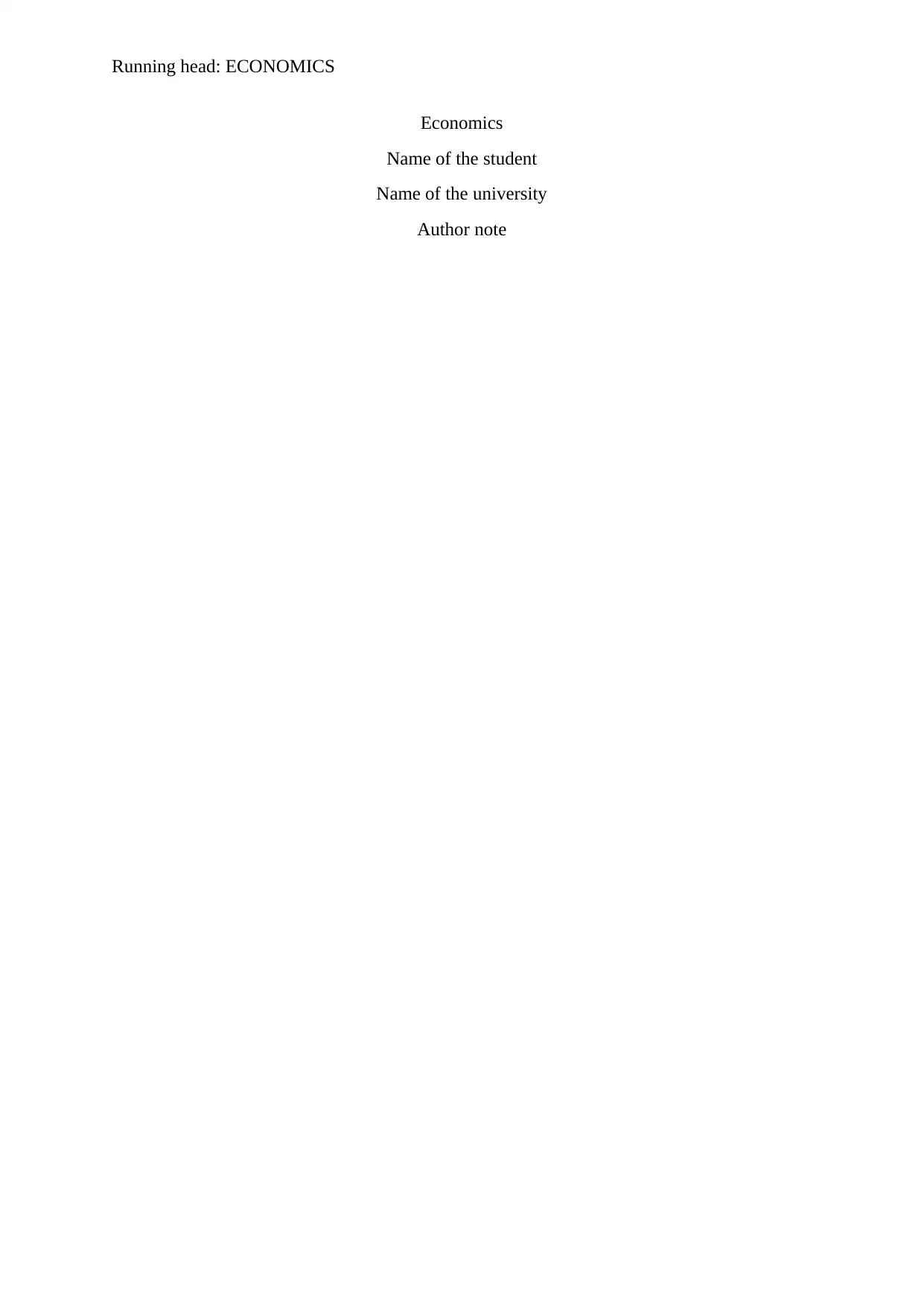
Running head: ECONOMICS
Economics
Name of the student
Name of the university
Author note
Economics
Name of the student
Name of the university
Author note
Paraphrase This Document
Need a fresh take? Get an instant paraphrase of this document with our AI Paraphraser
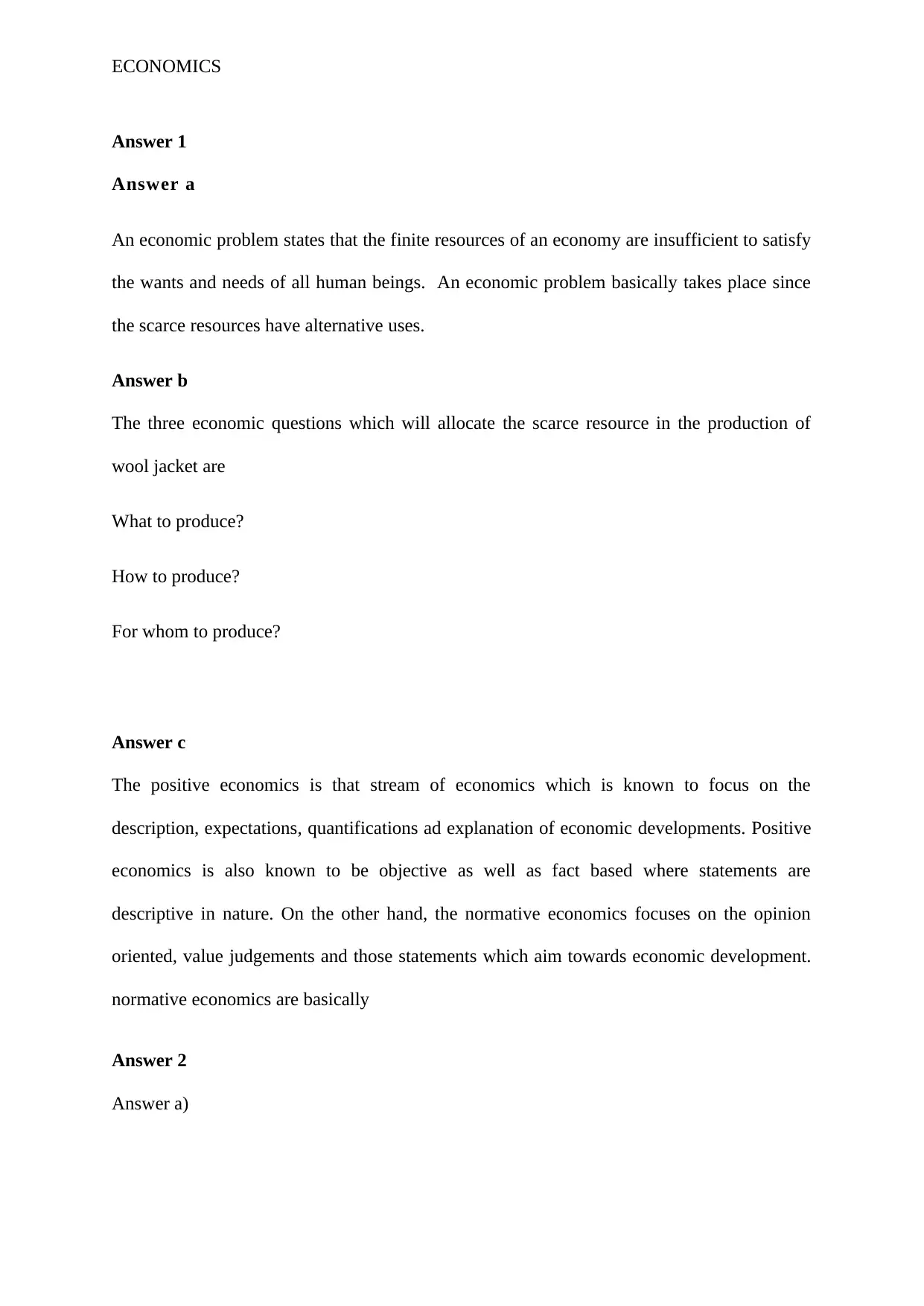
ECONOMICS
Answer 1
Answer a
An economic problem states that the finite resources of an economy are insufficient to satisfy
the wants and needs of all human beings. An economic problem basically takes place since
the scarce resources have alternative uses.
Answer b
The three economic questions which will allocate the scarce resource in the production of
wool jacket are
What to produce?
How to produce?
For whom to produce?
Answer c
The positive economics is that stream of economics which is known to focus on the
description, expectations, quantifications ad explanation of economic developments. Positive
economics is also known to be objective as well as fact based where statements are
descriptive in nature. On the other hand, the normative economics focuses on the opinion
oriented, value judgements and those statements which aim towards economic development.
normative economics are basically
Answer 2
Answer a)
Answer 1
Answer a
An economic problem states that the finite resources of an economy are insufficient to satisfy
the wants and needs of all human beings. An economic problem basically takes place since
the scarce resources have alternative uses.
Answer b
The three economic questions which will allocate the scarce resource in the production of
wool jacket are
What to produce?
How to produce?
For whom to produce?
Answer c
The positive economics is that stream of economics which is known to focus on the
description, expectations, quantifications ad explanation of economic developments. Positive
economics is also known to be objective as well as fact based where statements are
descriptive in nature. On the other hand, the normative economics focuses on the opinion
oriented, value judgements and those statements which aim towards economic development.
normative economics are basically
Answer 2
Answer a)
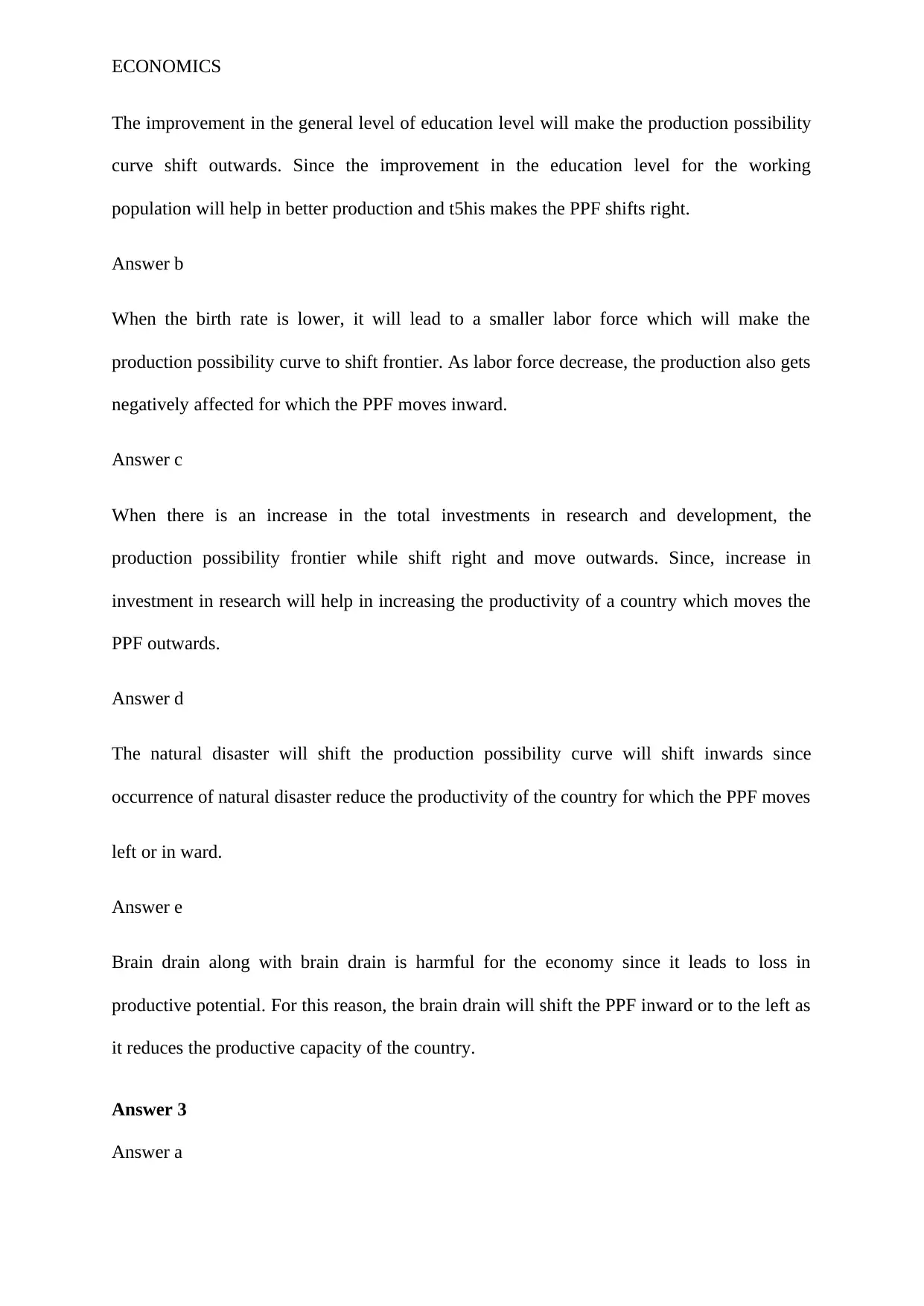
ECONOMICS
The improvement in the general level of education level will make the production possibility
curve shift outwards. Since the improvement in the education level for the working
population will help in better production and t5his makes the PPF shifts right.
Answer b
When the birth rate is lower, it will lead to a smaller labor force which will make the
production possibility curve to shift frontier. As labor force decrease, the production also gets
negatively affected for which the PPF moves inward.
Answer c
When there is an increase in the total investments in research and development, the
production possibility frontier while shift right and move outwards. Since, increase in
investment in research will help in increasing the productivity of a country which moves the
PPF outwards.
Answer d
The natural disaster will shift the production possibility curve will shift inwards since
occurrence of natural disaster reduce the productivity of the country for which the PPF moves
left or in ward.
Answer e
Brain drain along with brain drain is harmful for the economy since it leads to loss in
productive potential. For this reason, the brain drain will shift the PPF inward or to the left as
it reduces the productive capacity of the country.
Answer 3
Answer a
The improvement in the general level of education level will make the production possibility
curve shift outwards. Since the improvement in the education level for the working
population will help in better production and t5his makes the PPF shifts right.
Answer b
When the birth rate is lower, it will lead to a smaller labor force which will make the
production possibility curve to shift frontier. As labor force decrease, the production also gets
negatively affected for which the PPF moves inward.
Answer c
When there is an increase in the total investments in research and development, the
production possibility frontier while shift right and move outwards. Since, increase in
investment in research will help in increasing the productivity of a country which moves the
PPF outwards.
Answer d
The natural disaster will shift the production possibility curve will shift inwards since
occurrence of natural disaster reduce the productivity of the country for which the PPF moves
left or in ward.
Answer e
Brain drain along with brain drain is harmful for the economy since it leads to loss in
productive potential. For this reason, the brain drain will shift the PPF inward or to the left as
it reduces the productive capacity of the country.
Answer 3
Answer a
⊘ This is a preview!⊘
Do you want full access?
Subscribe today to unlock all pages.

Trusted by 1+ million students worldwide
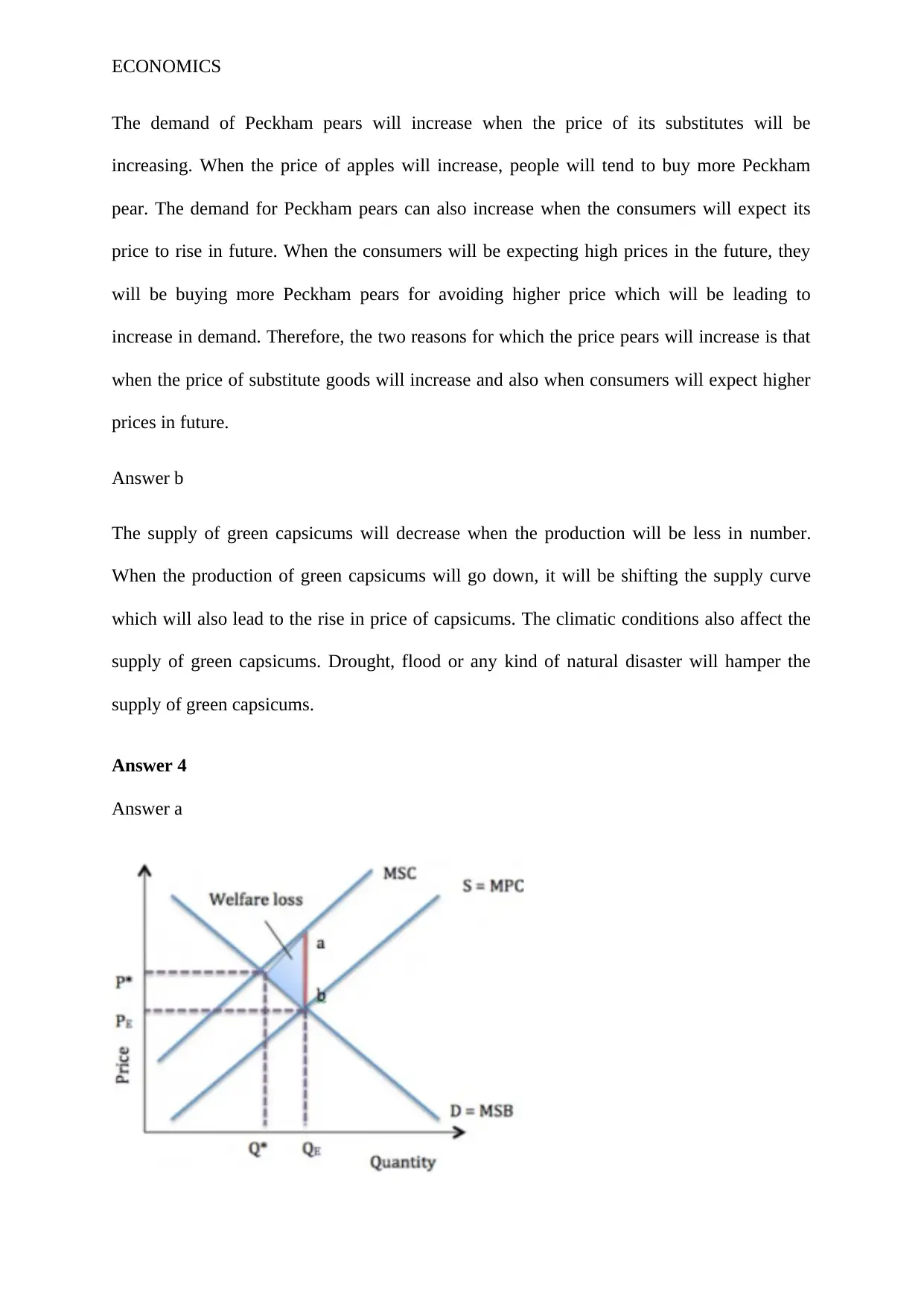
ECONOMICS
The demand of Peckham pears will increase when the price of its substitutes will be
increasing. When the price of apples will increase, people will tend to buy more Peckham
pear. The demand for Peckham pears can also increase when the consumers will expect its
price to rise in future. When the consumers will be expecting high prices in the future, they
will be buying more Peckham pears for avoiding higher price which will be leading to
increase in demand. Therefore, the two reasons for which the price pears will increase is that
when the price of substitute goods will increase and also when consumers will expect higher
prices in future.
Answer b
The supply of green capsicums will decrease when the production will be less in number.
When the production of green capsicums will go down, it will be shifting the supply curve
which will also lead to the rise in price of capsicums. The climatic conditions also affect the
supply of green capsicums. Drought, flood or any kind of natural disaster will hamper the
supply of green capsicums.
Answer 4
Answer a
The demand of Peckham pears will increase when the price of its substitutes will be
increasing. When the price of apples will increase, people will tend to buy more Peckham
pear. The demand for Peckham pears can also increase when the consumers will expect its
price to rise in future. When the consumers will be expecting high prices in the future, they
will be buying more Peckham pears for avoiding higher price which will be leading to
increase in demand. Therefore, the two reasons for which the price pears will increase is that
when the price of substitute goods will increase and also when consumers will expect higher
prices in future.
Answer b
The supply of green capsicums will decrease when the production will be less in number.
When the production of green capsicums will go down, it will be shifting the supply curve
which will also lead to the rise in price of capsicums. The climatic conditions also affect the
supply of green capsicums. Drought, flood or any kind of natural disaster will hamper the
supply of green capsicums.
Answer 4
Answer a
Paraphrase This Document
Need a fresh take? Get an instant paraphrase of this document with our AI Paraphraser
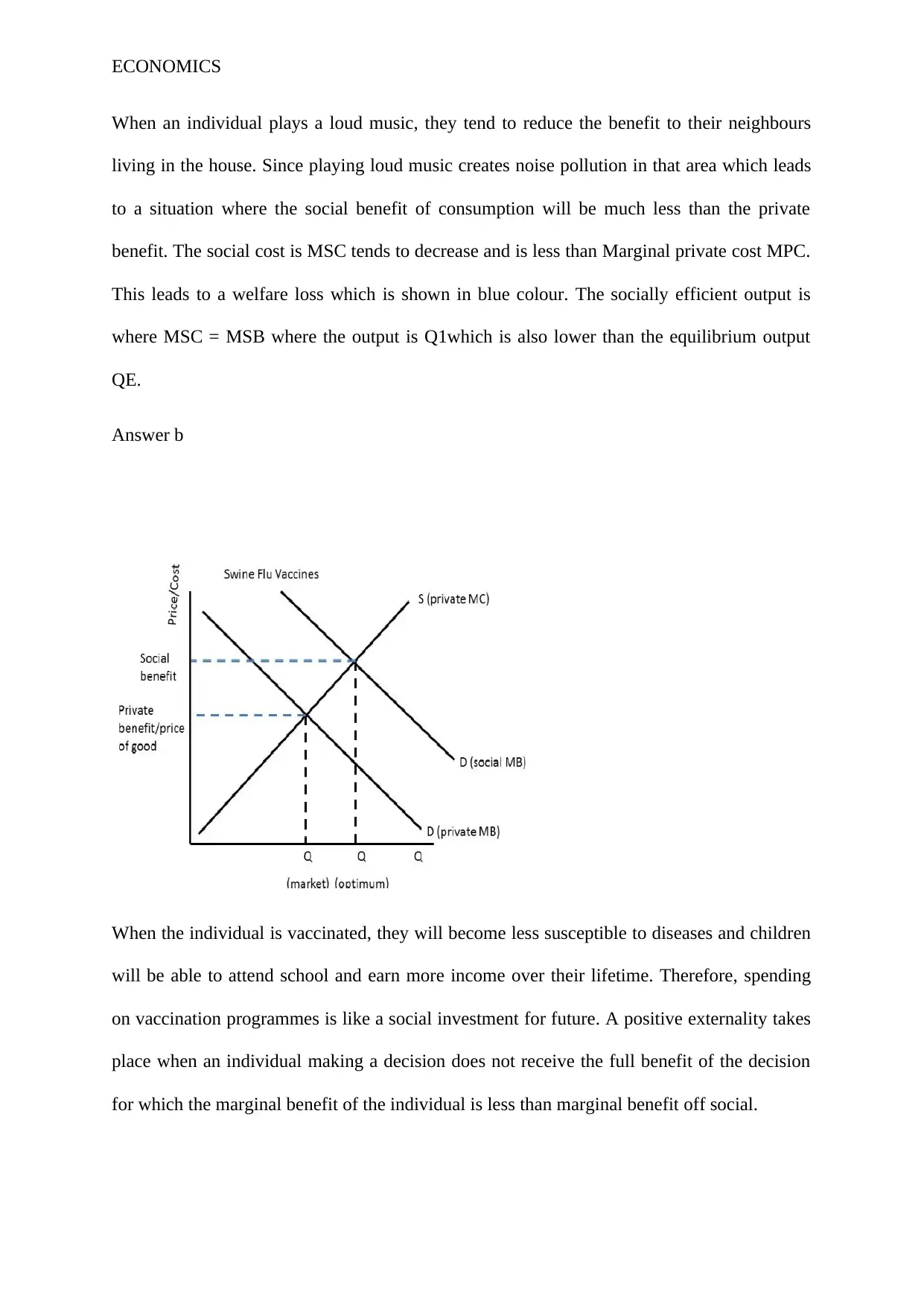
ECONOMICS
When an individual plays a loud music, they tend to reduce the benefit to their neighbours
living in the house. Since playing loud music creates noise pollution in that area which leads
to a situation where the social benefit of consumption will be much less than the private
benefit. The social cost is MSC tends to decrease and is less than Marginal private cost MPC.
This leads to a welfare loss which is shown in blue colour. The socially efficient output is
where MSC = MSB where the output is Q1which is also lower than the equilibrium output
QE.
Answer b
When the individual is vaccinated, they will become less susceptible to diseases and children
will be able to attend school and earn more income over their lifetime. Therefore, spending
on vaccination programmes is like a social investment for future. A positive externality takes
place when an individual making a decision does not receive the full benefit of the decision
for which the marginal benefit of the individual is less than marginal benefit off social.
When an individual plays a loud music, they tend to reduce the benefit to their neighbours
living in the house. Since playing loud music creates noise pollution in that area which leads
to a situation where the social benefit of consumption will be much less than the private
benefit. The social cost is MSC tends to decrease and is less than Marginal private cost MPC.
This leads to a welfare loss which is shown in blue colour. The socially efficient output is
where MSC = MSB where the output is Q1which is also lower than the equilibrium output
QE.
Answer b
When the individual is vaccinated, they will become less susceptible to diseases and children
will be able to attend school and earn more income over their lifetime. Therefore, spending
on vaccination programmes is like a social investment for future. A positive externality takes
place when an individual making a decision does not receive the full benefit of the decision
for which the marginal benefit of the individual is less than marginal benefit off social.
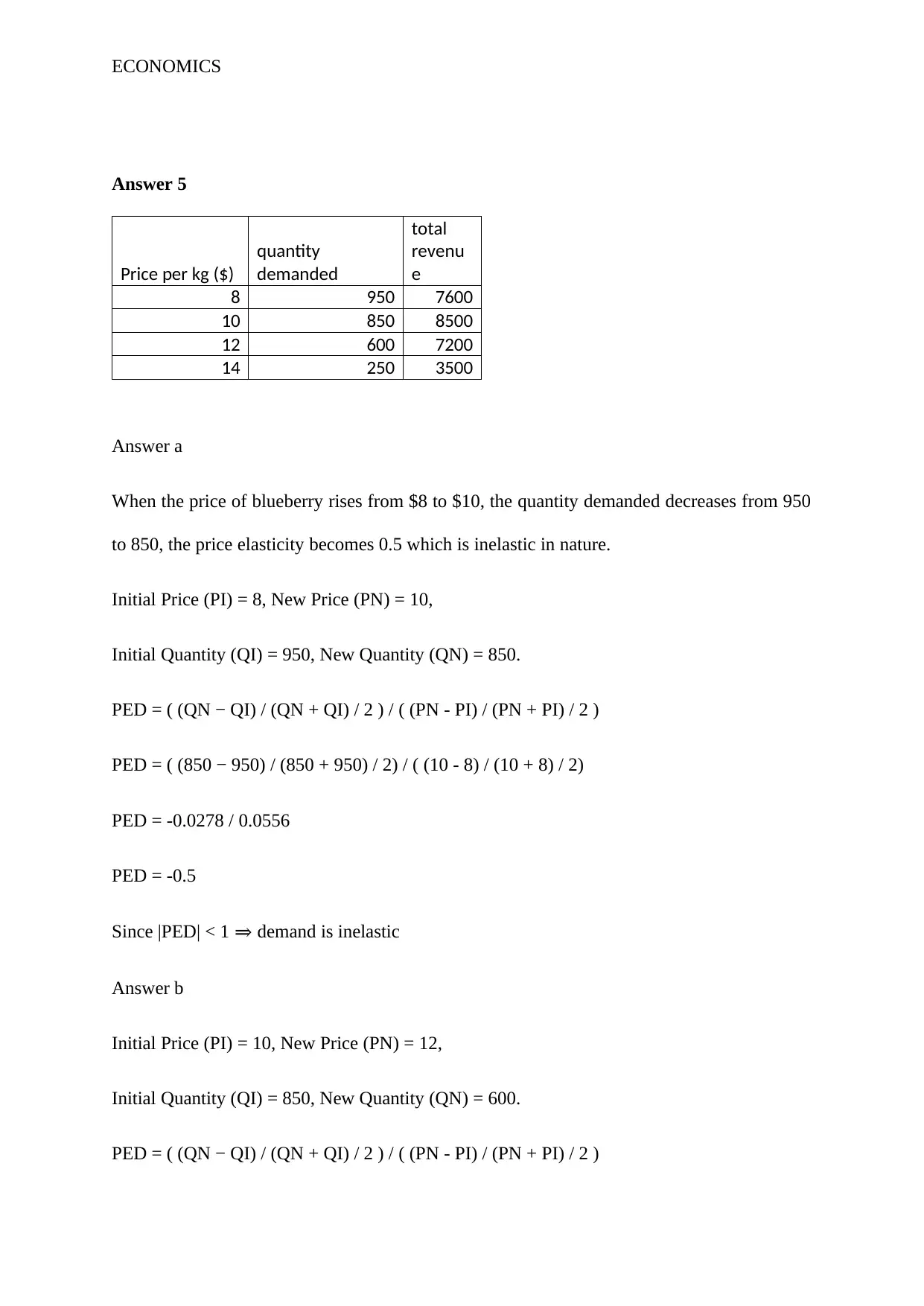
ECONOMICS
Answer 5
Price per kg ($)
quantity
demanded
total
revenu
e
8 950 7600
10 850 8500
12 600 7200
14 250 3500
Answer a
When the price of blueberry rises from $8 to $10, the quantity demanded decreases from 950
to 850, the price elasticity becomes 0.5 which is inelastic in nature.
Initial Price (PI) = 8, New Price (PN) = 10,
Initial Quantity (QI) = 950, New Quantity (QN) = 850.
PED = ( (QN − QI) / (QN + QI) / 2 ) / ( (PN - PI) / (PN + PI) / 2 )
PED = ( (850 − 950) / (850 + 950) / 2) / ( (10 - 8) / (10 + 8) / 2)
PED = -0.0278 / 0.0556
PED = -0.5
Since |PED| < 1 ⇒ demand is inelastic
Answer b
Initial Price (PI) = 10, New Price (PN) = 12,
Initial Quantity (QI) = 850, New Quantity (QN) = 600.
PED = ( (QN − QI) / (QN + QI) / 2 ) / ( (PN - PI) / (PN + PI) / 2 )
Answer 5
Price per kg ($)
quantity
demanded
total
revenu
e
8 950 7600
10 850 8500
12 600 7200
14 250 3500
Answer a
When the price of blueberry rises from $8 to $10, the quantity demanded decreases from 950
to 850, the price elasticity becomes 0.5 which is inelastic in nature.
Initial Price (PI) = 8, New Price (PN) = 10,
Initial Quantity (QI) = 950, New Quantity (QN) = 850.
PED = ( (QN − QI) / (QN + QI) / 2 ) / ( (PN - PI) / (PN + PI) / 2 )
PED = ( (850 − 950) / (850 + 950) / 2) / ( (10 - 8) / (10 + 8) / 2)
PED = -0.0278 / 0.0556
PED = -0.5
Since |PED| < 1 ⇒ demand is inelastic
Answer b
Initial Price (PI) = 10, New Price (PN) = 12,
Initial Quantity (QI) = 850, New Quantity (QN) = 600.
PED = ( (QN − QI) / (QN + QI) / 2 ) / ( (PN - PI) / (PN + PI) / 2 )
⊘ This is a preview!⊘
Do you want full access?
Subscribe today to unlock all pages.

Trusted by 1+ million students worldwide
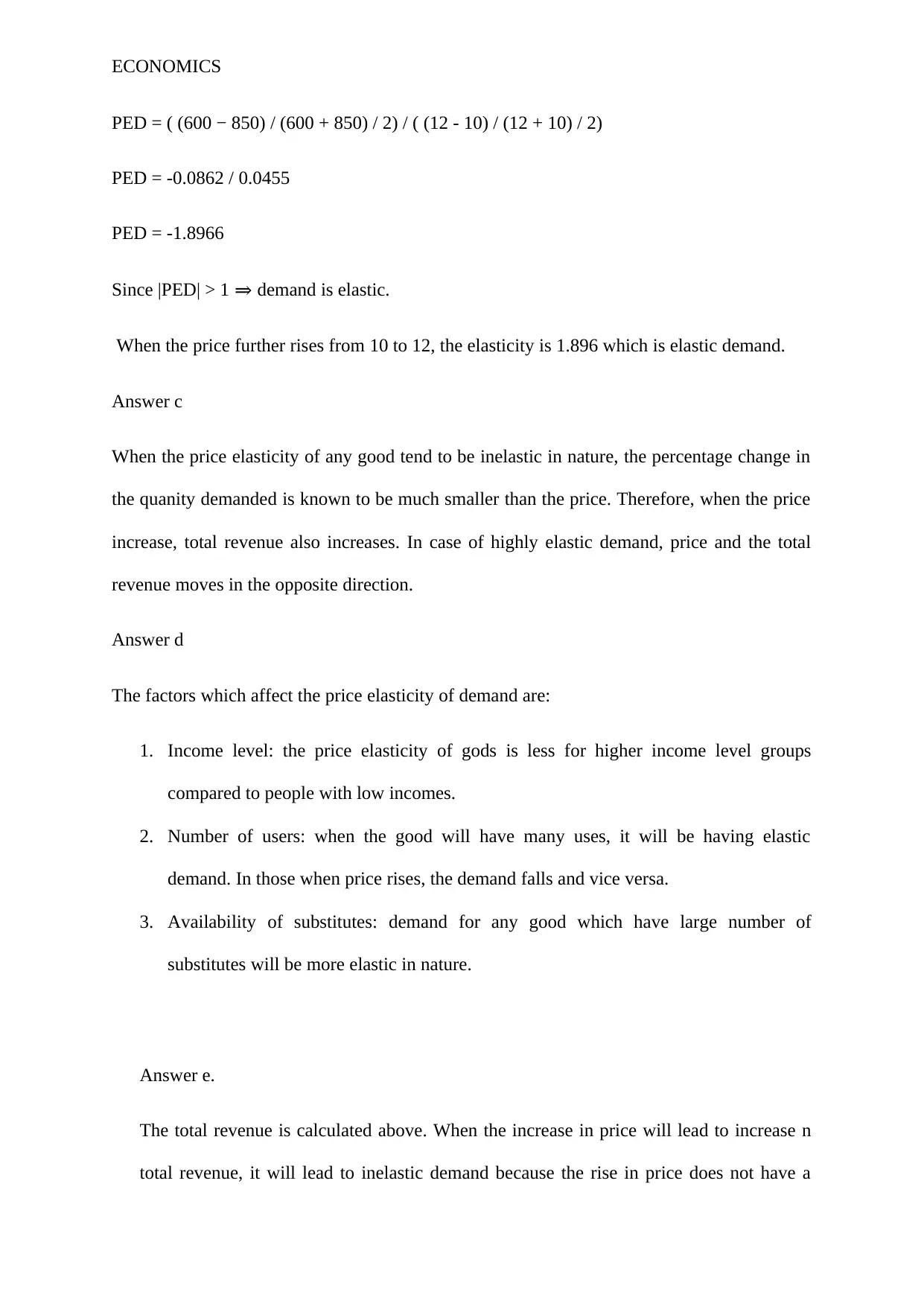
ECONOMICS
PED = ( (600 − 850) / (600 + 850) / 2) / ( (12 - 10) / (12 + 10) / 2)
PED = -0.0862 / 0.0455
PED = -1.8966
Since |PED| > 1 ⇒ demand is elastic.
When the price further rises from 10 to 12, the elasticity is 1.896 which is elastic demand.
Answer c
When the price elasticity of any good tend to be inelastic in nature, the percentage change in
the quanity demanded is known to be much smaller than the price. Therefore, when the price
increase, total revenue also increases. In case of highly elastic demand, price and the total
revenue moves in the opposite direction.
Answer d
The factors which affect the price elasticity of demand are:
1. Income level: the price elasticity of gods is less for higher income level groups
compared to people with low incomes.
2. Number of users: when the good will have many uses, it will be having elastic
demand. In those when price rises, the demand falls and vice versa.
3. Availability of substitutes: demand for any good which have large number of
substitutes will be more elastic in nature.
Answer e.
The total revenue is calculated above. When the increase in price will lead to increase n
total revenue, it will lead to inelastic demand because the rise in price does not have a
PED = ( (600 − 850) / (600 + 850) / 2) / ( (12 - 10) / (12 + 10) / 2)
PED = -0.0862 / 0.0455
PED = -1.8966
Since |PED| > 1 ⇒ demand is elastic.
When the price further rises from 10 to 12, the elasticity is 1.896 which is elastic demand.
Answer c
When the price elasticity of any good tend to be inelastic in nature, the percentage change in
the quanity demanded is known to be much smaller than the price. Therefore, when the price
increase, total revenue also increases. In case of highly elastic demand, price and the total
revenue moves in the opposite direction.
Answer d
The factors which affect the price elasticity of demand are:
1. Income level: the price elasticity of gods is less for higher income level groups
compared to people with low incomes.
2. Number of users: when the good will have many uses, it will be having elastic
demand. In those when price rises, the demand falls and vice versa.
3. Availability of substitutes: demand for any good which have large number of
substitutes will be more elastic in nature.
Answer e.
The total revenue is calculated above. When the increase in price will lead to increase n
total revenue, it will lead to inelastic demand because the rise in price does not have a
Paraphrase This Document
Need a fresh take? Get an instant paraphrase of this document with our AI Paraphraser
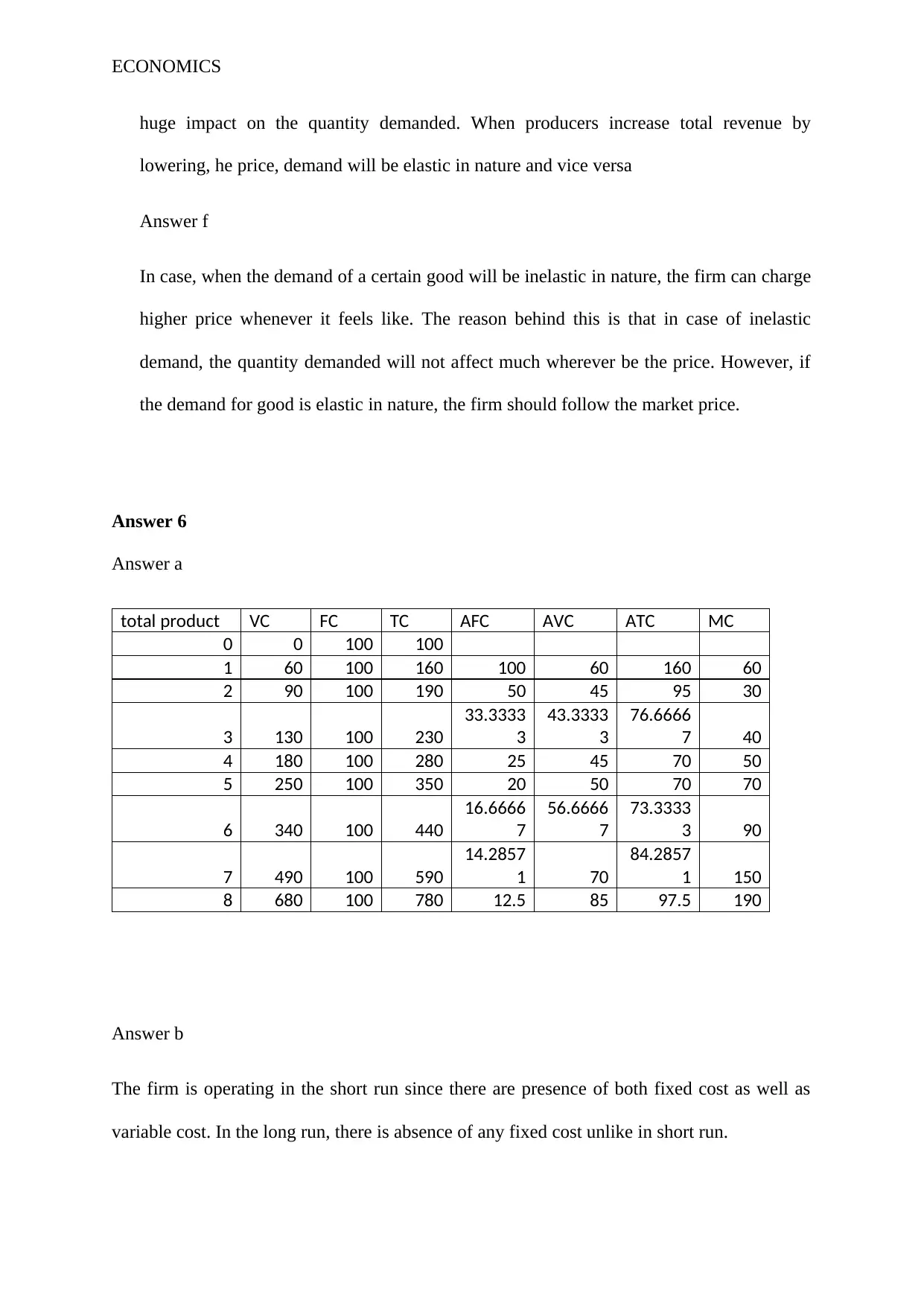
ECONOMICS
huge impact on the quantity demanded. When producers increase total revenue by
lowering, he price, demand will be elastic in nature and vice versa
Answer f
In case, when the demand of a certain good will be inelastic in nature, the firm can charge
higher price whenever it feels like. The reason behind this is that in case of inelastic
demand, the quantity demanded will not affect much wherever be the price. However, if
the demand for good is elastic in nature, the firm should follow the market price.
Answer 6
Answer a
total product VC FC TC AFC AVC ATC MC
0 0 100 100
1 60 100 160 100 60 160 60
2 90 100 190 50 45 95 30
3 130 100 230
33.3333
3
43.3333
3
76.6666
7 40
4 180 100 280 25 45 70 50
5 250 100 350 20 50 70 70
6 340 100 440
16.6666
7
56.6666
7
73.3333
3 90
7 490 100 590
14.2857
1 70
84.2857
1 150
8 680 100 780 12.5 85 97.5 190
Answer b
The firm is operating in the short run since there are presence of both fixed cost as well as
variable cost. In the long run, there is absence of any fixed cost unlike in short run.
huge impact on the quantity demanded. When producers increase total revenue by
lowering, he price, demand will be elastic in nature and vice versa
Answer f
In case, when the demand of a certain good will be inelastic in nature, the firm can charge
higher price whenever it feels like. The reason behind this is that in case of inelastic
demand, the quantity demanded will not affect much wherever be the price. However, if
the demand for good is elastic in nature, the firm should follow the market price.
Answer 6
Answer a
total product VC FC TC AFC AVC ATC MC
0 0 100 100
1 60 100 160 100 60 160 60
2 90 100 190 50 45 95 30
3 130 100 230
33.3333
3
43.3333
3
76.6666
7 40
4 180 100 280 25 45 70 50
5 250 100 350 20 50 70 70
6 340 100 440
16.6666
7
56.6666
7
73.3333
3 90
7 490 100 590
14.2857
1 70
84.2857
1 150
8 680 100 780 12.5 85 97.5 190
Answer b
The firm is operating in the short run since there are presence of both fixed cost as well as
variable cost. In the long run, there is absence of any fixed cost unlike in short run.
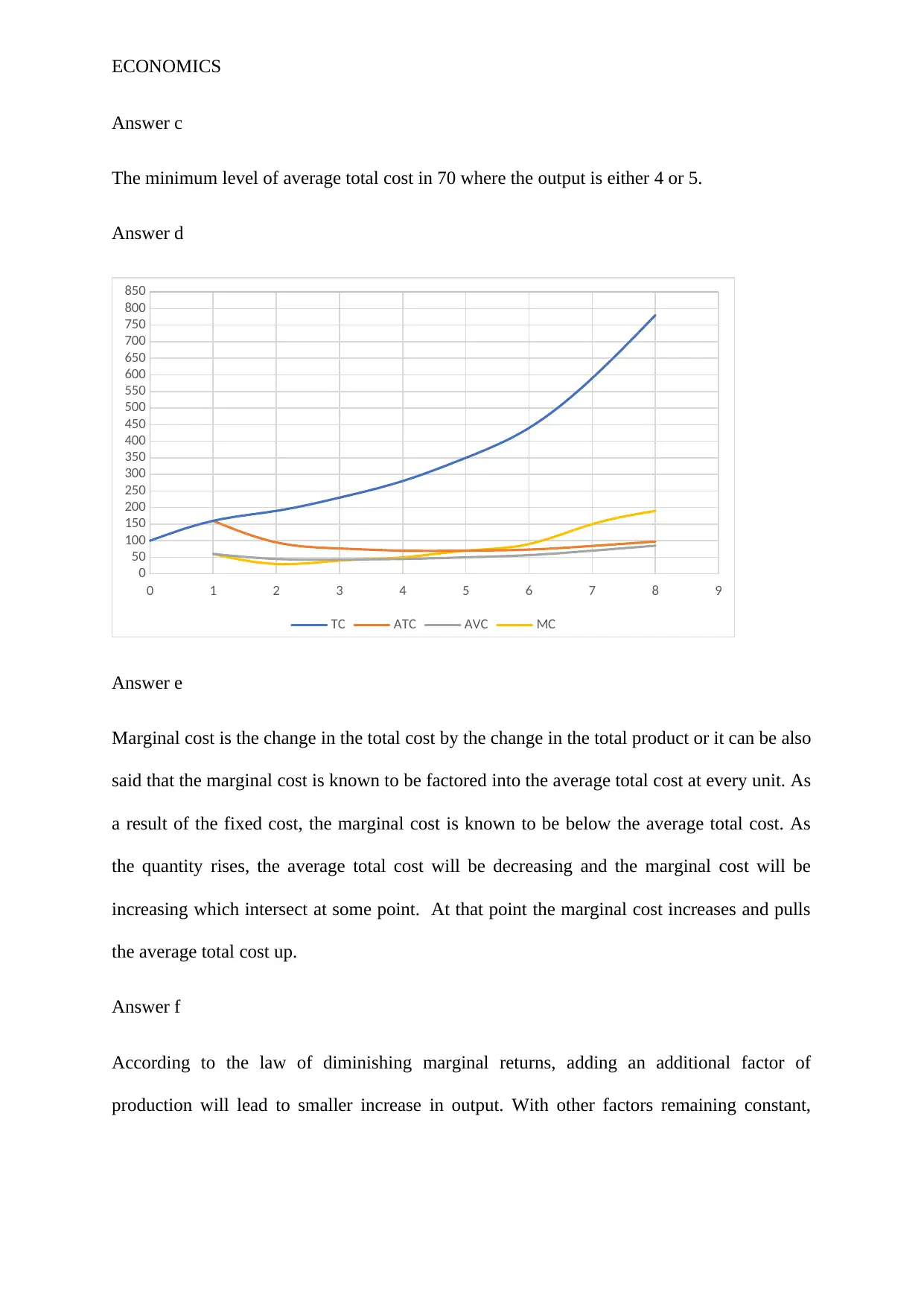
ECONOMICS
Answer c
The minimum level of average total cost in 70 where the output is either 4 or 5.
Answer d
0 1 2 3 4 5 6 7 8 9
0
50
100
150
200
250
300
350
400
450
500
550
600
650
700
750
800
850
TC ATC AVC MC
Answer e
Marginal cost is the change in the total cost by the change in the total product or it can be also
said that the marginal cost is known to be factored into the average total cost at every unit. As
a result of the fixed cost, the marginal cost is known to be below the average total cost. As
the quantity rises, the average total cost will be decreasing and the marginal cost will be
increasing which intersect at some point. At that point the marginal cost increases and pulls
the average total cost up.
Answer f
According to the law of diminishing marginal returns, adding an additional factor of
production will lead to smaller increase in output. With other factors remaining constant,
Answer c
The minimum level of average total cost in 70 where the output is either 4 or 5.
Answer d
0 1 2 3 4 5 6 7 8 9
0
50
100
150
200
250
300
350
400
450
500
550
600
650
700
750
800
850
TC ATC AVC MC
Answer e
Marginal cost is the change in the total cost by the change in the total product or it can be also
said that the marginal cost is known to be factored into the average total cost at every unit. As
a result of the fixed cost, the marginal cost is known to be below the average total cost. As
the quantity rises, the average total cost will be decreasing and the marginal cost will be
increasing which intersect at some point. At that point the marginal cost increases and pulls
the average total cost up.
Answer f
According to the law of diminishing marginal returns, adding an additional factor of
production will lead to smaller increase in output. With other factors remaining constant,
⊘ This is a preview!⊘
Do you want full access?
Subscribe today to unlock all pages.

Trusted by 1+ million students worldwide
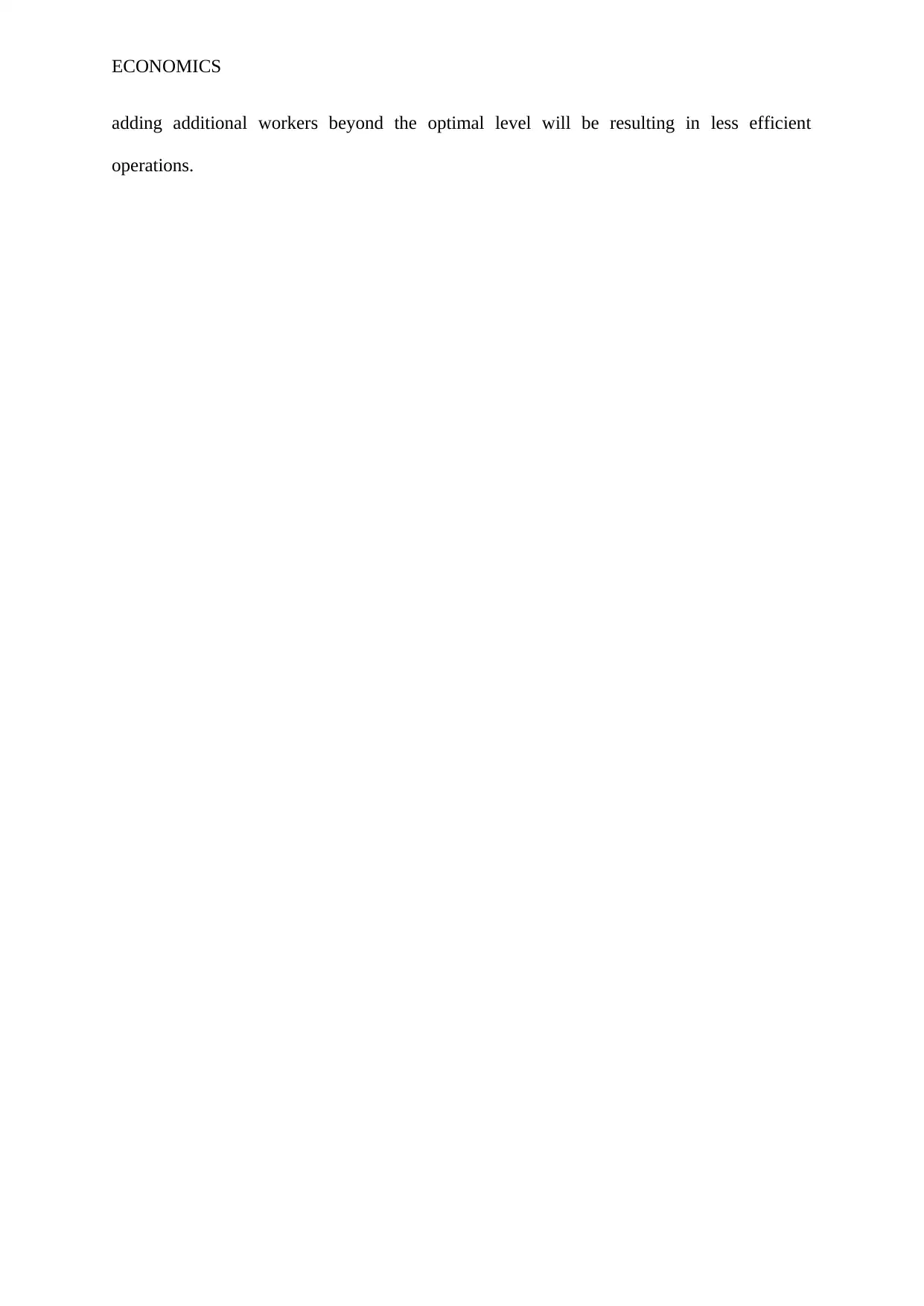
ECONOMICS
adding additional workers beyond the optimal level will be resulting in less efficient
operations.
adding additional workers beyond the optimal level will be resulting in less efficient
operations.
Paraphrase This Document
Need a fresh take? Get an instant paraphrase of this document with our AI Paraphraser
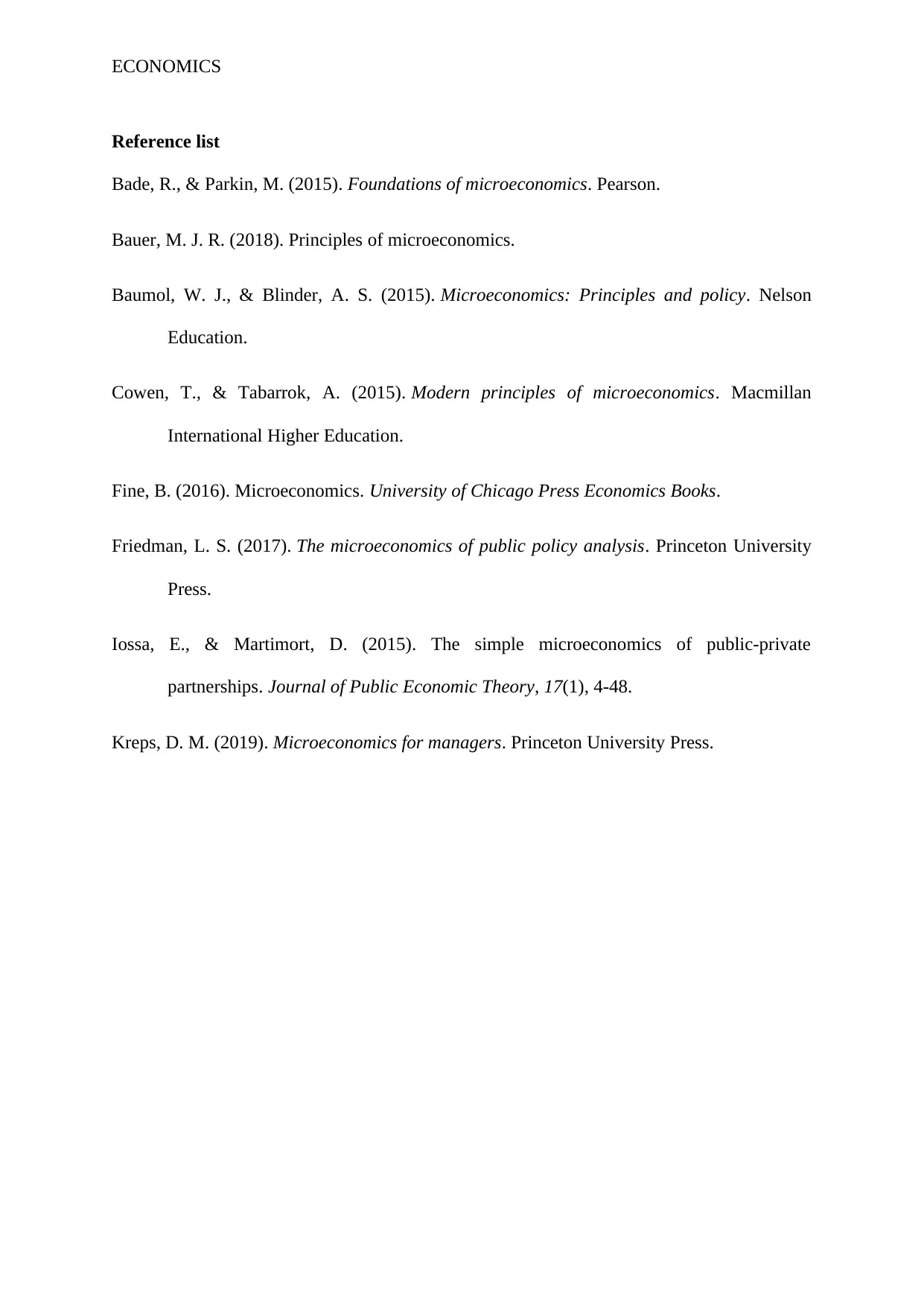
ECONOMICS
Reference list
Bade, R., & Parkin, M. (2015). Foundations of microeconomics. Pearson.
Bauer, M. J. R. (2018). Principles of microeconomics.
Baumol, W. J., & Blinder, A. S. (2015). Microeconomics: Principles and policy. Nelson
Education.
Cowen, T., & Tabarrok, A. (2015). Modern principles of microeconomics. Macmillan
International Higher Education.
Fine, B. (2016). Microeconomics. University of Chicago Press Economics Books.
Friedman, L. S. (2017). The microeconomics of public policy analysis. Princeton University
Press.
Iossa, E., & Martimort, D. (2015). The simple microeconomics of public‐private
partnerships. Journal of Public Economic Theory, 17(1), 4-48.
Kreps, D. M. (2019). Microeconomics for managers. Princeton University Press.
Reference list
Bade, R., & Parkin, M. (2015). Foundations of microeconomics. Pearson.
Bauer, M. J. R. (2018). Principles of microeconomics.
Baumol, W. J., & Blinder, A. S. (2015). Microeconomics: Principles and policy. Nelson
Education.
Cowen, T., & Tabarrok, A. (2015). Modern principles of microeconomics. Macmillan
International Higher Education.
Fine, B. (2016). Microeconomics. University of Chicago Press Economics Books.
Friedman, L. S. (2017). The microeconomics of public policy analysis. Princeton University
Press.
Iossa, E., & Martimort, D. (2015). The simple microeconomics of public‐private
partnerships. Journal of Public Economic Theory, 17(1), 4-48.
Kreps, D. M. (2019). Microeconomics for managers. Princeton University Press.
1 out of 11
Related Documents
Your All-in-One AI-Powered Toolkit for Academic Success.
+13062052269
info@desklib.com
Available 24*7 on WhatsApp / Email
![[object Object]](/_next/static/media/star-bottom.7253800d.svg)
Unlock your academic potential
Copyright © 2020–2025 A2Z Services. All Rights Reserved. Developed and managed by ZUCOL.




